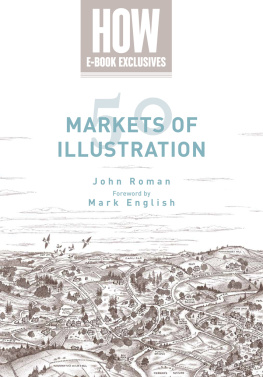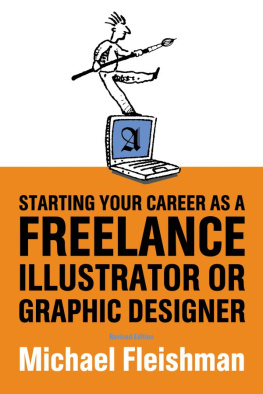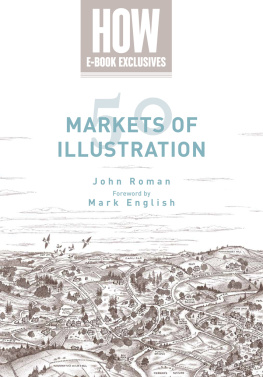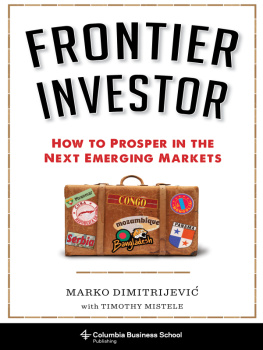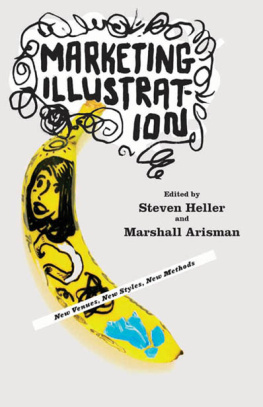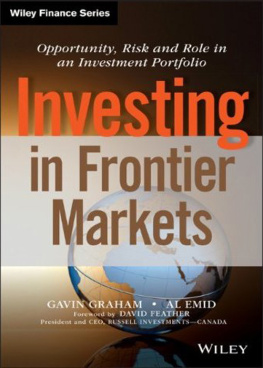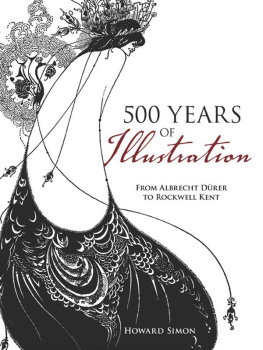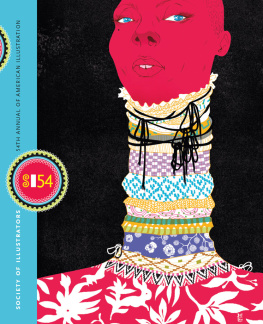Thank you for purchasing this How Design eBook.
Sign up for our newsletter and receive special offers, access to free content, and information on the latest new releases and must-have designing resources! Plus, receive a coupon code to use on your first purchase from MyDesignShop.com for signing up.
or visit us online to sign up at
http://howdesign.com/ebook-promo
Contents
DEDICATION
For all my students: past, present, and future.
Foreword
THE CHANGING PATHS TO AN ILLUSTRATION CAREER
By Mark English
The illustration field is very different than when I first began my career in the 1960s. After graduation from Art Center College, I was employed as a designer at an ad agency and later at a design studio. Those creative surroundings exposed me to talented illustrators whose work influenced my decision to focus on illustration; first with the automotive industry in Detroit, then in New York where I established a broader market for my art. At that time, the glory days of editorial art were still strong and I felt Id found my calling as a magazine illustrator, but new influences would soon see that era in decline.
Today young illustrators are being hit with competition from all sides: stock agencies, shrinking creative budgets, fewer jobs, and countless other illustrators with whom to compete both domestically and internationally. Its just tougher to make a name for yourself in this world. But, as John Roman points out in this book, there is still a high demand for excellent, beautifully executed illustrationonly the paths to those jobs have changed. In the 21st century art world its crucial to network within the industry and to identify your personal skills and strengths. John pinpoints thriving peripheral markets that offer boundless opportunities for those illustrators willing to search.
While the illustration industry is dramatically different now, some things have remained constant. I cant stress enough the importance of basic skillsgood drawing, color, and compositionbecause those attributes of good illustration never change. Developing a passion and finding your individual voice can only come with constant observation, practice, honest self-evaluation, and a 24/7 commitment to ones art. No computer can think for the artist. Art is a never-ending evolution.
Mark English has been one of the leading illustrators in the US and abroad for three decades. His unique style is easily recognizable, and appears in publications such as McCalls, Time, Sports Illustrated, Redbook, and The Atlantic Monthly. He has won hundreds of awards for his work and is the most awarded illustrator in the history of the Society of Illustrators in New York. His client list includes such notables as IBM, the U.S. Park Service, RCA, General Electric, Ford, General Motors, and Honeywell.
Preface
CONTEMPORARY ILLUSTRATION
There is a bit of irony in the fact that this book, about the different fields of illustration, was conceived inside the Norman Rockwell Museuma shrine not only to the worlds most famous illustrator but also to the illustration industry as a whole. However, the concept for the 50 Markets of Illustration was prompted more by an assumed need to explain my own work as an illustrator than it was by sheer creative inspiration.
Each year the Norman Rockwell Museum sponsors the annual Berkshire County High School Art Show where students from Western Massachusetts display a variety of artwork. The opening reception always includes a presentation by a guest artist, and in February 2010, I was honored to speak about my career as a freelance illustrator.
My initial pride turned to a slight concern during the days leading up to the event. Rockwells classic paintings and illustrations are a fixture in the public mind, but my illustrations are in no way similar to the art of Norman Rockwell. I specialize mainly in technical drawings, architectural art, and illustrated maps, and was apprehensive that the audience might not relate to the specific nature of my art.
On the day of the talk, instead of immediately showing my work, I began with an off-the-cuff explanation of the illustration field as a whole, first describing the markets Rockwell focused oneditorial, book, and advertising illustrationthen surprising myself by spontaneously listing ten or so other areas or markets where illustrators specialize. This unplanned opening enabled a smooth transition into the technical art in my PowerPoint, and I sensed that the audience had a genuine interest in this bit of insight. Their response sparked a curiosity in me as to just how many markets actually exist for illustrators andthroughout the remainder of 2010 and all of 2011the exploration of illustration markets turned into a personal project. The initial list continued to broaden as I discussed the topic with colleagues, friends, illustrators, professors, as well as with my students at the Massachusetts College of Art and Design. Many branches of the industry, of which I was unfamiliar, were brought to light, and my own gaps of knowledge embarrassed meuntil I discovered most illustration professionals shared my limited view of the business.
In 2012, I summarized my findings in 45 Markets of Illustration, a column appearing in that years edition of the Communication Arts Illustration Annual. The following year Suffolk Universitys New England School of Art & Design in Boston held a group exhibition inspired by the article. The exhibition, Contemporary Illustration: At Your Service, featured the works of illustrators from around the world each representing a different illustration market.
The prologue in the shows catalogue hints at a possible reason for the boundaries that exist in contemporary illustration and foretells of a more all-encompassing future. Look at the illustrations in any recent juried competition or annual and you will see art that rivals or surpasses the caliber of work produced in any other historic period. Yet, that work may not even reflect the full picture of illustration as practiced today, it states. One need not look far to see clear signs that the illustration field is approaching a new threshold, one that is redefining the parameters of what constitutes contemporary illustration. It is the intention of this book to widen the spotlight on our profession to a full 360-degrees and illuminate the full spectrum of current illustration.
The innumerable ways artists seek to create art and forge their careers is impressive. An internal quest seems evident in all illustratorsa pursuit for the career that best reverberates with their personal enthusiasm. Robert Bly, in his notable poetic fashion, aptly illuminates this truth:
Like musical instruments, the human brain strikes chords that may or may not vibrate or resonate. The brain seeks that which it can resonate with, and it must resonate in order to keep itself healthy and alive.
While the 50 Markets of Illustration may have begun simply as a means of defining to a small group my place in this brimming and historic field, it has evolved into a tribute of the multitudes of creators in this profession with the hope that it will serve as a guide for future illustrators in search of their own individual, artistic resonance.
John Roman
Contemporary Illustration: At Your Service! An exhibition at The New England School of Art and Design at Suffolk University; March 16 April 28, 2013

